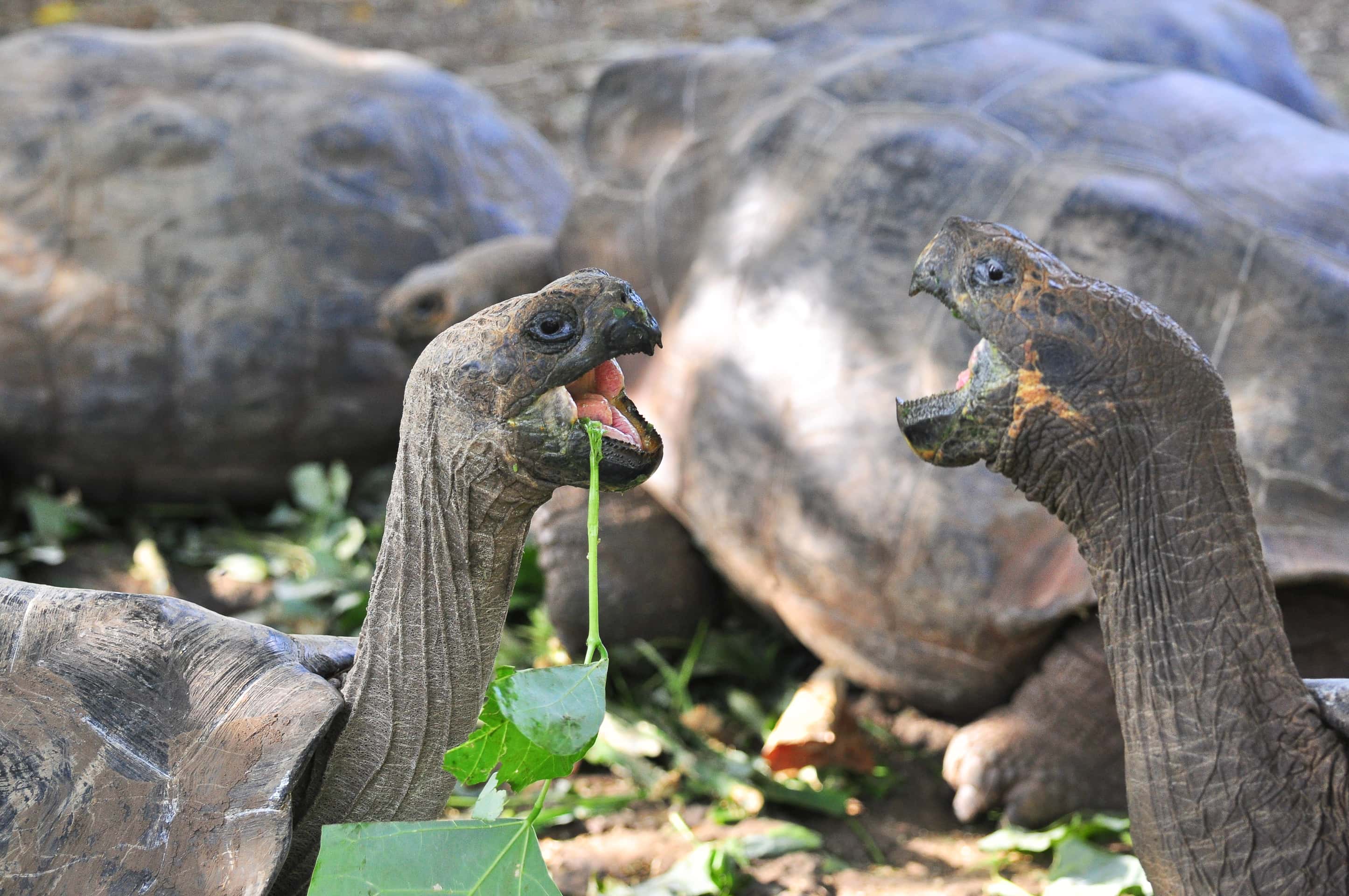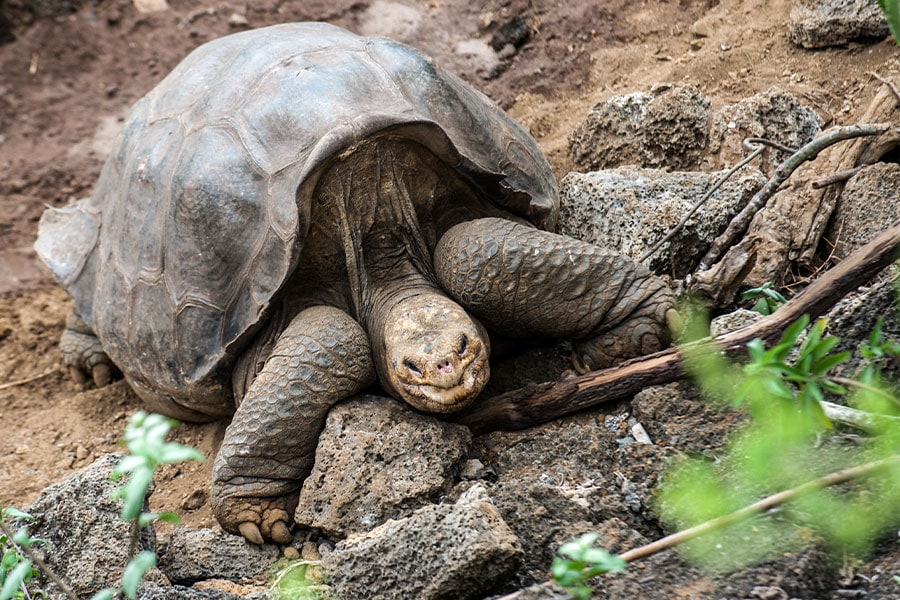
What You Need To Know About the Galapagos Giant Tortoise
Did you know that the Spanish word for tortoise is galápago? It makes complete sense then that the volcanic islands of the Galapagos Archipelago were named by Spanish sailors who explored the region in 1535 due to the abundance of giant tortoises. Once thought to be the home of 250,000 tortoises, the Galapagos tortoise only numbers 15,000 today due to the severe exploitation by whalers, buccaneers and fur sealers, with only 13 living species thought to remain across the ten islands. Here’s what you need to know about the Galapagos giant tortoise when you visit!
Size matters
When we say giant, we’re not talking in hyperboles. We really do mean gigantic. The average size of the Galapagos tortoise is 1.5 metres, growing to a maximum of 1.8 metres, and weighing up to 400 kilograms…trust us, you do not want a giant tortoise sitting on you! They are among the biggest species in the world, originating from South America, East Africa, and/or Madagascar. But how did they get so big?
Despite the interest from naturalists since Darwin’s time, the evolution of gigantism in tortoises remains a mystery. Research on other animals point to the so-called island rule: that insular gigantism comes about from the release from predatory pressure – meaning the Galapagos tortoises were able to grow larger because they were not hunted as prey. However, studies remain inconclusive, as fossils suggest their size is not linked to islands. More likely, they are ancestors of larger species that migrated two to three millions of years ago. Galapagos giant tortoises can live up to 100 years in the wild but even longer in captivity – the oldest tortoise on record was 175-years old when she died in Australia Zoo on 23 June 2006!
Shells by the Seashore
While there is a large variation in size and shape, the Galapagos giant tortoises are classed into two main shell types: domed-shaped and saddle-backed. The naturalist Charles Darwin noticed there was a difference in shell shapes according to each island, reaching the conclusion that they changed from one single ancestor to the different environments of each island, although the saddle-backed shape is thought to have evolved independently.
Giant Galapagos tortoises born in wet, humid islands like Santa Cruz are characterized by dome-shaped shells, which keep their heads low and limit their food sources to that at ground level such as grass, fallen leaves and other plants. For tortoises born on drier islands like San Cristóbal, saddleback shells with raised rims allow them to raise their necks higher and feed from bushes or low-hanging branches. Saddleback shells have a flared front opening that allows the animals to extend their necks to reach tall cacti. While the tortoises themselves are heavy, the shells are not as they are made up of honeycomb-shaped air chambers, which make their load lighter. The shells are also part of their skeleton and cannot be removed – growing with the tortoise to its age of maturity around 20 to 25 years old.
Along with their lean diet of grasses, leaves, fruits and cactus pads, a healthy regime of sunbathing and rest for nearly 16 hours per day have contributed to their long life expectancy. They are also able to survive up to a year without eating or drinking thanks to a slow metabolism and an ability to store large amounts of water!
Slow but Sure
While tortoises have always been characterized as slow, they are actually faster than we think. By faster, we mean they can go as far as 13 km in just two days during the males’ mating season. When they are not hurrying about, the Galapagos giant tortoise spends an average of 16 hours per day resting, eating grass, bathing in water and getting cleaned by Galapagos finches who often can be seen sitting on the backs of giant tortoises.

Breeding season occurs during the hot season between January and May, and can last for several hours, with the male making loud roaring noises throughout. Post mating, the female finds a nesting area where she will dig a hole to lay two to 16 eggs, each the size of a tennis ball. Fun fact: Because the nests are essentially 12-inch deep sand holes, the female tortoises will urinate inside to keep the sand from collapsing on the eggs! Incubation then takes 130 days, after which young Galapagos giant tortoises will hatch, hopefully not smelling of pee.
Last of Their Kind
Many of the Galapagos giant tortoises subspecies are listed by the International Union for Conservation of Nature as endangered or critically endangered. In 2012, the death of a beloved hundred-year-old giant tortoise named Lonesome George became a global symbol of the need to protect endangered species. As the last of his kind, Lonesome George’s death marked the extinction of the Pinta Island tortoise (Chelonoidis abingdonii), however the rediscovery of a Fernandina Island giant tortoise (Chelonoidis phantastica) in 2019 signals hope for a species previously thought to be extinct.

Guests aboard our Galapagos cruise will be able to witness the conservation work undertaken by the Ecuadorian government in tandem with the Galapagos National Park to protect the tortoises’ dwindling population from the introduction of several species such as rats, pigs, feral dogs, cattle and horses by humans into their habitat. The Charles Darwin foundation work in Española, Santa Cruz and Isabela islands with four different tortoise species (Chelonoidis hoodensis, C. porteri, C. donfaustoi and C. vandenburghi), using tracking devices such as GPS and VHF to understand the movements of adult and juvenile tortoises in their natural environment.

A highlight of our itinerary is a visit to the Fausto Llerana Tortoise Center on Santa Cruz Island, a long-term program run jointly by the Galapagos National Park Directorate and the Charles Darwin Foundation from 1965 to save the giant tortoise population on Pinzón, expanding quickly to include other populations, in particular that of Española where only 14 individuals remained. As of 2008, more than 4,000 young tortoises from eight different populations have been repatriated to their island of origin, with nearly 1,500 going back to Española. At the Tortoise Center, visitors can observe a variety of tortoises, including hatchlings, juveniles, and full-grown individuals.
Book an expedition on Aqua Mare, the ultimate retreat while exploring the dramatic volcanic landscapes of the Galapagos Archipelago. Exclusivity is combined with the most personalized service enabled by two naturalist guides for 16 guests, on top of the islands’ most exclusive one-to-one crew to guest ratio. Find out more from our reservations team or at www.aquaexpeditions.com.



